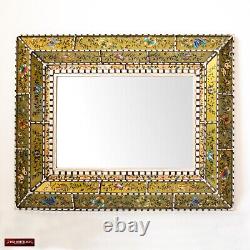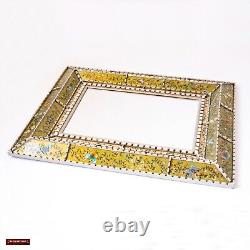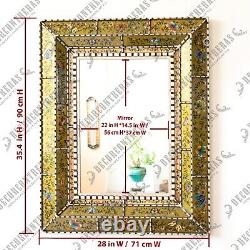Peruvian Hand-Painted glass Rectangle Mirror wall art decor, Green Large Mirror










Decorative Wall Mirror, "Queens" - Wall Decor - Peruvian Handicrafts. The beauty of butterflies dancing among flowers is reflected in this beautiful, rectangular-shaped mirror with a silver edge.
The Peruvian painted glass technique in the backside can be seen in this beautiful, colorful design with butterflies and flowers. This glamorous handmade large mirror will add that luxury look to your bathroom, bedroom, dining room hallway or entry way. It hangs vertically and horizontally. It's arrives ready to hang.
Mirror Handmade 100% by Peruvian artisans. We welcome any questions you may hav e. Edmundo Contreras, 1st place winner in the UNESCO Crafts Prize for Latin America / Caribbean (painted glass-1995). Edmundo Contreras, Received the Medal of Vizcardo and Guzman as a master artisan, awarded by the Congress of the Republic of Peru in 2002.
Winner of the award for best export quality product issued by ICC-MINCETUR PROYECT PERU (2003). Prize: Most outstanding company in the "EXPORTING ROUTE" by the Ministry of Foreign Trade of Peru and PROMPERU (2014).Prize: Most outstanding company in the category "EXPORTA EASY" by Ministry of Foreign Trade of Peru and PROMPERU (2016). 35.4" H x 28" W x 2.1 D (90 cm H x 71 cm W x 5.5 cm D). 22" H x 14.5" (56 cm H x 37 cm W). 16.3 Lb (7.42 Kg). This mirror can be placed vertically or horizontally.
In the XV Century, glass arrived in Peru brought by the Spaniards in the form of mirrors and picture. Frames destined to decorate churches, convents and houses of the time.
Also, they brought beads from Murano, an Italian island next to Venice, where the greatest production of glass and crystal, between the XVIII and XIX, took place. The Spanish technique of stained glass windows, of great Arab influence, were copied and modified by Peruvian craftsmen. They developed new regional styles, such as the andahuaylino (reverse-painted glass frames), the cajamarquino (thoroughly painted glass), the Cusco style (carved wood frames that include painted glass), the mixed style or cuscaja (using gold leaf on the carved picture frames and on painted glass) and the polychrome style (using multiple multicolored hues). These styles can be observed in museum collections, in decoration of church altars and convents of different regions of the Perú.

